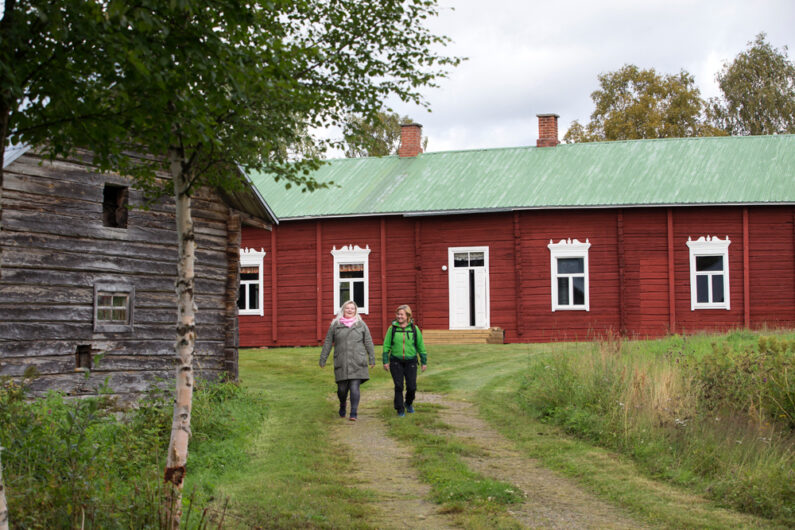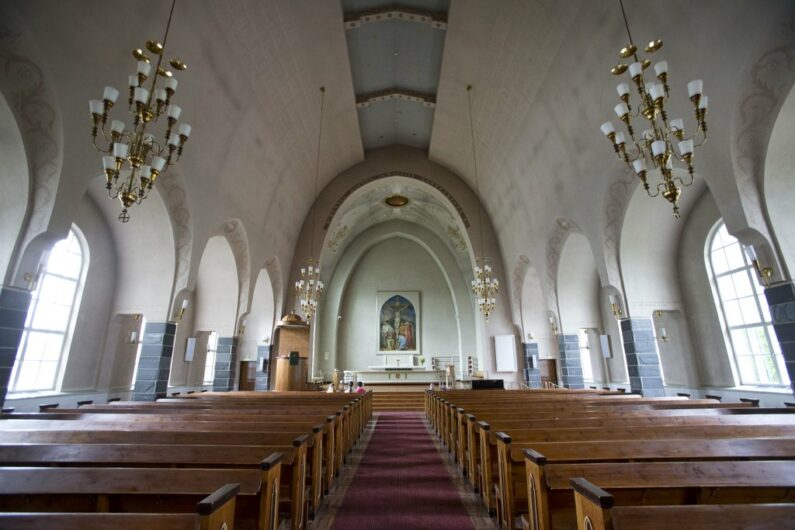Historic sites
History of the villages

The village of Luusua in Kemijärvi has been inhabited since prehistoric times. Artifacts found in the Stone and Iron Age settlements of Neitiharjju indicate that the area has been inhabited since before the beginning of the Common Era. The numerous layers of the settlements, as well as the ‘iron smelters’, prove that prehistoric settlement continued until the Iron Age, from around 1100 to 1200. Ancient iron knives, knives and arrowheads made from lake ores have been found on the site.
In addition, an ancient settlement site from the late Middle Ages has been found in the village of Sopolla in Kemijärvi. In the old Lapinkylä village of Soproda, pieces of skis, an iron axe and an old Sámi settlement have been found. Visit the Ämmänvaara nature trail which is an old Sámi sacred site.
It’s quite possible that while walking in the forest, you may come across ancient stone cairns or even ancient Lappish fish scavengers. These ancient sites have remained popular places of residence for Kemijärvi residents to this day.
Settlement of Kemijärvi
Settlement in the Kemijärvi region became established in the 1700s. The old architecture of the Kemijärvi region has its origins in various factors. The most important part of it comes from the traditions that the settlers in the river valley brought with them from their former homelands. Usually, the tradition of the homeland was only preserved as long as the settlers themselves carved their own bastards. The stylistic trends and innovations of each period were quickly transported by the Kemijoki River from the centres to the heart of the wilderness. The Kemijoki valley was the birthplace of a relatively coherent architecture in the hinterland. You can still see old birch buildings in the village of Juujärvi or by visiting the Kemijärvi Local Heritage Museum
Water
The water body has played an important role in the spread of settlement to Kemijärvi, and later in the development of access routes and growing industry.
Shipping on the Kemijoki River began in the early 1900s, when large smelting boats boosted trade and traffic. Service connections and travel routes were needed, and when the land road network was incomplete, waterways provided a natural route for passengers.
Winter War
During the Winter War, the Soviet 596. I Battalion of the Infantry Regiment was tasked to hook up to Mäntyvaara and cut the Salla-Kemijärvi road from the west side of Joutsijärvi. The battalion had made its way on foot to the rear of the Finns, but the Finnish Detached Battalion 17, which was on rest duty, spotted the enemy and engaged in battle. The battle cut off the advance of the Soviet soldiers. In Mäntyvaara there is a monument erected by the Finns, a memorial stone to the Soviet soldiers who fell in the battle and mass graves.
During the inter-peace period, the northernmost battle station chain on the Salpalinja was built in the village of Joutsijärvi, with five bunkers. One of the bunkers in Joutsijärvi is now used as a tourist attraction, which can be visited all year round.
According to the Armistice Agreement of September 1944, Finland was obliged, if necessary, to disarm and expel German troops in northern Finland. For this reason, an order was issued in early September to evacuate the civilian population of northern Finland and their movable property to the safest areas. The German troops retreating from Salla burned almost everything, and only 11 buildings in the church village were spared. Soldiers who had been on the spot had placed placards on the doors of designated houses, instructing them not to burn the marked buildings. The Kemijärvi Church belfry from 1774 was one of these.
Military historical sites in Eastern Lapland
The Military Historical Sites of Eastern Lapland is a geographic information service operated by the Eastern Lapland Association of Local Authorities. It is intended as a source of information for tourists and anyone interested in military history.
The site brings together military historical sites in Eastern Lapland and on the Russian side, near the border. The sites date from the Civil War, the Winter War, the inter-peace period and the Continuation War.
The service provides information for self-tourists about the military history and sites of Eastern Lapland. We hope you will use the site to plan your holiday or learn about the military history of the region from home. You can visit a single site, tour the sites in your home municipality or take a military history tour through all the municipalities!
Concrete bunkers in Joutsijärvi

During the Winter War, the advance of the Red Army was halted at Joutsijärvi on 16 December 1939. The Soviet troops attempted to attack from the eastern border through Kemijärvi to Finland’s western border. On 15 January 1940, the Soviet troops withdrew from Joutsijärvi 45 km to Märkäjärvi (now Salla). On 19 January 1940, the Finnish offensive was halted at Paikanselkä in Salla, where the front lines remained until the end of the Winter War.
Salpalinja is a chain of defensive fortifications built during the inter-war period on Finland’s eastern border. The Joutsijärvi Fortified Battlegrounds are the northernmost bunker area of the Salpalinja. Five concrete bunkers are located in the area, some of which have been restored and are open to the public all year round. The bunker houses a photographic exhibition on the construction of the Salpalinja and war artefacts from the area. Next to the public site is the Hunajalampi hut and a nature trail with information about the military history of Lake Joutsijärvi.
German base at Joutsijärvi 1941-1944
When the Germans arrived in Eastern Lapland in the summer of 1941, they established a base at Joutsijärvi. The facilities at Joutsijärvi included an air base, a military barracks, a hospital, a driving school, a cinema and various accommodation, maintenance and storage facilities. There were also prison camps in the area. When the Germans withdrew in the autumn of 1944, they destroyed the barracks and mined the area. The concrete bunkers are open all year round and are located in the village of Joutsijärvi.
Hunajalammentie 35, 98710 Kemijärvi, Finland
Further information: info.visit@kemijarvi.fi
Mäntyvaara battlefield
During the Winter War, the Soviet 596. I Battalion of the Infantry Regiment was tasked to hook up to Mäntyvaara and cut the Salla-Kemijärvi road from the west side of Joutsijärvi. The battalion had made its way on foot to the rear of the Finns, but the Finnish Detached Battalion 17, which was on rest duty, spotted the enemy and engaged in battle. After a fierce battle in the twilight of the afternoon and darkness of the evening on 20 December 1939, the Finns managed to capture the danger and the Soviet troops were destroyed.
17 Finns and more than 300 Soviet soldiers were killed in the battle. There is a monument erected by the Finns, a memorial to the Soviet soldiers who died in the battle and mass graves. There are also Soviet mass graves in Joutsijärvi in Vuosamonselkä, Jokiselkä, Ahonieiemi and on the eastern side of Lake Alakappalejärvi.
The terrain of Mäntyvaara also shows the battle stations dug on its slopes by conscripts before the battle of Mäntyvaara. Near the memorial there is also a memorial stone to two Swedish volunteers who died in the Winter War. Mäntyvaara was the site of a prison camp run by the Germans during the Continuation War. Those who died in the prisoner-of-war camp are buried in Mäntyvaara. On the north-western slope of Mäntyvaara there is a mass grave of 380 prisoners of war, marked by a red cone.
Sallantie 2137, 98710 Kemijärvi, Finland
Kemijärvi church

Kemijärvi, on the Kemijoki River, was a fishing area for both Sámi and Kemites in the 1500s. Gradually, however, settlers began to move in and settle along the beautiful bays of the multi-branched lake. By the mid-16th century, there were already more than a dozen houses and fifty inhabitants on its shores. In the summer, the population increased as the Lapps and Kemites came there for their annual fishing trips. For centuries, the Kemijoki River had been used to reach both the Arctic Ocean and the White Sea. Kemijärvi belonged regionally to the parish of Kemi and was located on the border between Lapland and Lanta.
Church work in Kemijärvi began in 1648, when Jakob Lapodius, a native of Lapua, was appointed chaplain of the parish of Kemi, with Kemijärvi as his base. Around this time, the first church of the parish was completed, which was probably similar in style and size to the old church in Sodankylä, which has survived from those times. In the 1690s, the building was demolished and a larger church was built in its place.
After the Fellmans, the post of vicar of Kemijärvi was again held for a hundred years by the Wegelius family. The first vicar was Johan Wegelius, a cousin of his more famous namesake who had been active in Tornio. During his time, in 1779, Kemijärvi became its own parish, including Kuolajärvi. After him, Henrik Wegelius and Johan Wegelius the younger served as vicars until 1860.
By the 1830s, the parish population was already over 1600 people, so it was decided to build a larger church. The old one was demolished and replaced by a wooden cruciform church according to Engel’s designs, which were used elsewhere in the country. It was repaired twice in the 1890s and again in 1929. The church was destroyed in the Lapland War when the Germans withdrew from Kemijärvi. The bell tower, dating from 1774, was saved. It was built by the church builder Heikki Väänänen from Ylikiimink and is the oldest building in the parish. The oldest surviving object is the church bell donated to the parish by Queen Kristiina, which is kept in the church hall. The parish’s oldest vestry dates back to 1724.
The present church of Kemijärvi parish was built after the war with donations from American Lutheran churches in 1949-1950. It was consecrated on Midsummer Day 1951. The church was designed by architect Bertil Liljeqvist and is very similar to the Rovaniemi church designed by the same architect. The church seats 850 and has a 41-voice organ built by Gerhard Schmid in 1984. The altarpiece, which depicts Christ being taken down from the cross, was painted by Aale Hakava.
The Kemijärvi parish has built three chapels for its activities, in Luusua, Tapionniemi and Räisälä. In addition, the congregation has a blessing chapel in Honkakankaa and a camping centre in the scenic Ailanganniemi. The renovated parish hall, completed in early 2007, serves as a venue for many events and houses the parish priest’s office.
Kemijärvi church
Kirkkokatu 11, 98100 Kemijärvi
+358 (0) 400 802 270
Parish Hall
Esaiaksenkatu 2, 98100 Kemijärvi, Finland
www.kemijarvi.seurakunta.net